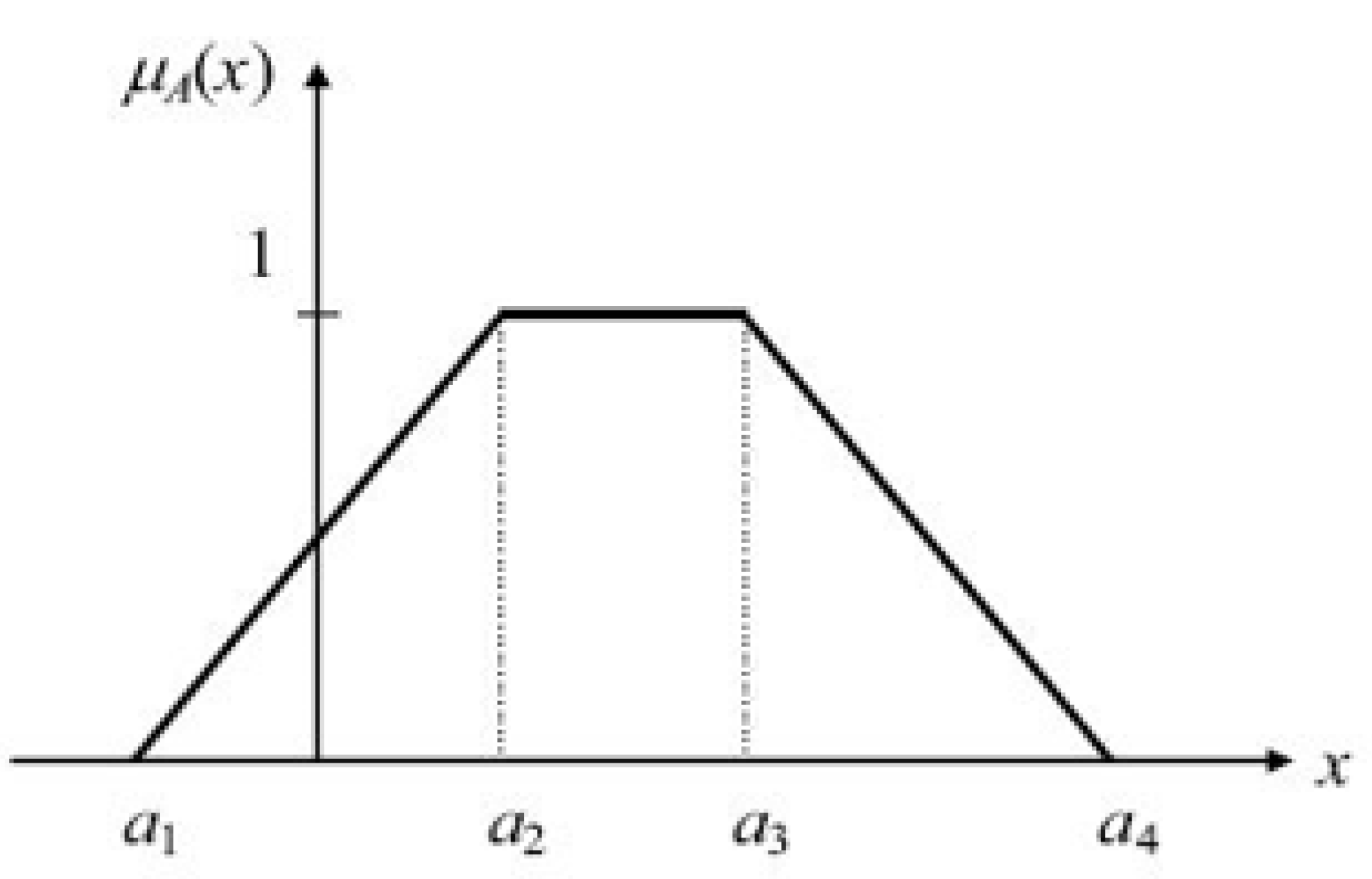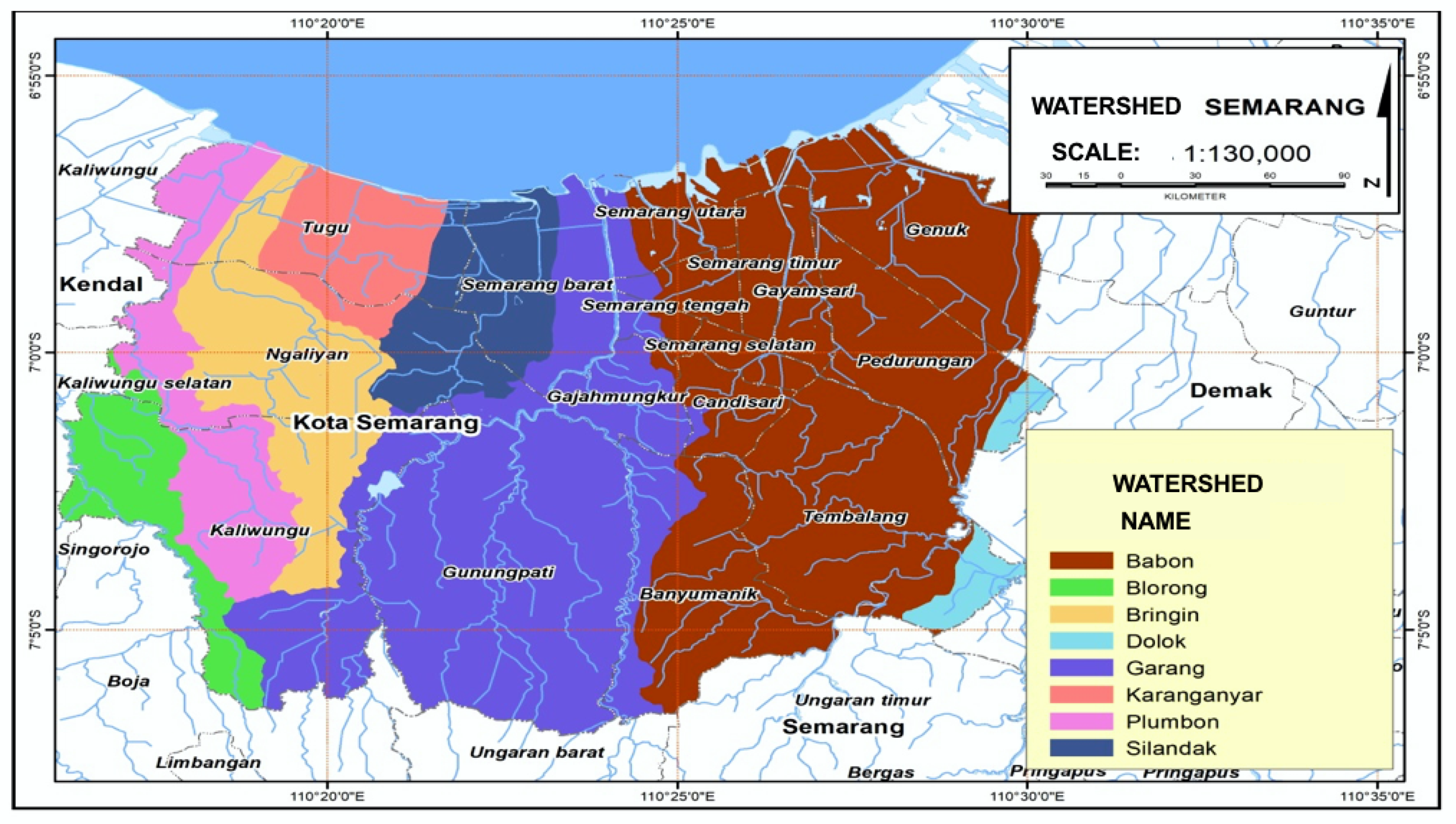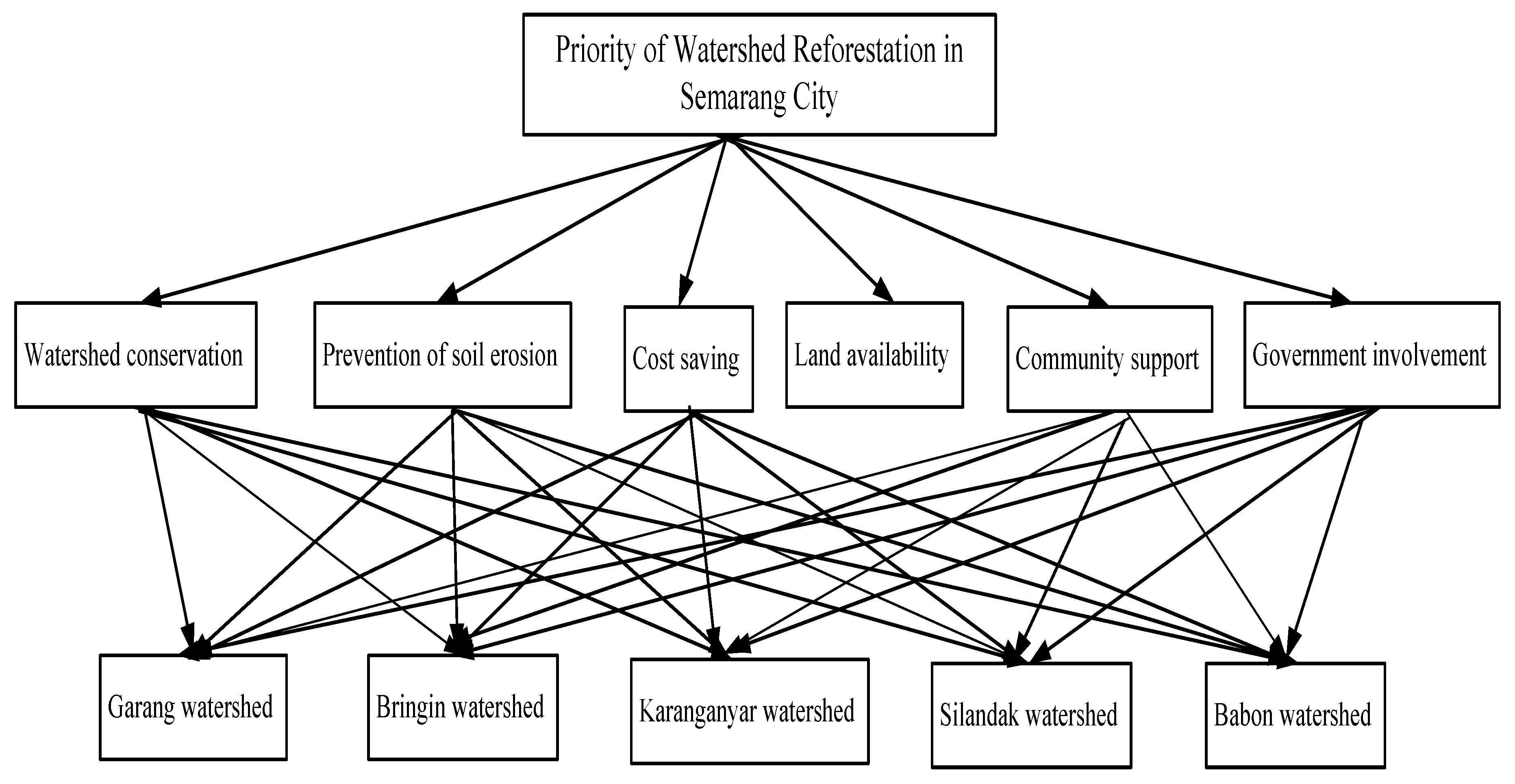1. Introduction
Fuzzy logic is considered as a strong technique of reasoning approaches by associating input with output spaces and mostly used for complicated system which is hardly solved by using a conventional mathematical model [
1]. The complexity of models is normally due to less accurate or unclear values of variables or parameters and therefore the mathematical models are hardly defined. VIKOR method is a new technique in fuzzy logic systems which is widely used for decision making problems. This method has been implemented by many researchers. Noordian [
2] used the method for selecting the reinforcement of natural fiber composition for car hoods. The results showed that VIKOR method can help identify the type of strengthening of the composition of natural fibers to be applied to laminated metal fibers to car hoods to achieve transit weight reduction. Santawy and Ahmed [
3] implemented VIKOR method for scholarship recipient selection. The results showed that the method could help the selection process and determine the scholarship recipients based on the criteria set and weighted by the employer. In addition, Salvius et al. [
4] demonstrated the use of VIKOR method to evaluate consulting firms and to evaluate the best company from a number of existing consulting companies. It showed that the VIKOR method can evaluate and rank consulting firms by setting some predetermined criteria to determine the right consulting company. Civic and Vucijak [
5] also used the VIKOR method as a method for material selection in wall insulation. They used the appropriate material for wall insulation by using several criteria that have been determined previously. The VIKOR method in this problem could obtain the best material ranking of every material available so the appropriate decision can be opted based on the results of the ranking that has been set. The selected material could reduce production costs, increase energy efficiency, and reduce CO
2 emissions. Santawy and Ahmed [
6] also used the VIKOR method as a project selection based on capital investment in every company. Several objectives are considered such as economic desires, environmental issues, and technical and social factors. The study showed that the VIKOR method can rank several projects and select one the appropriate one.
Watershed is an area where natural resources, especially vegetation, soil, and water, are found and stored, and a place for humans to use those natural resources to meet their needs [
7]. As an area, watershed is also regarded as an ecosystem of the water cycle, and therefore watershed is also defined as an area of land which unites rivers and streams, which has function of conserving naturally rainfall into the sea or the lake [
8]. In the study of watersheds, the presence of land boundary must be considered. It is an area of waters that is still influenced by activities in land side [
9]. Therefore, watersheds are also defined as natural areas which provide productive benefits and water supply through rivers, groundwater, and/or springs, to fulfill various needs of life for humans, wildlife, and plants. In order to obtain optimal and sustainable benefits, it is crucial to design an objective and rational watershed management planning system. In fact, watershed management planning is dynamic because the processes occurring within watershed, either natural, political, institutional, socio-economic, or technological processes, continue to develop. Reforestation in urban watersheds is, in fact, a crucial issue because it aims to not only preserve urban water supply but also prevent soil erosion [
10]. Regarding the importance of watersheds, it is vital to always maintain good conditions of watersheds in order for them to function properly.
An increase in population has caused an increase in the need for lands for humans to live in, making the needs for land very vital at this time. Unfortunately, development carried out by humans often does not pay attention to environmental carrying capacity. This then results in the degradation of land and the physical conditions of the land. In fact, natural resources such as soil and water area are prone to damage or degradation. In addition, other human activities that may damage watersheds are excessive logging or deforestation, human settlement project, conversion of forest land to plantations, and agricultural lands [
11].
There are five watersheds in Semarang City—i.e., Garang watershed, Bringin watershed, Karanganyar watershed, Silandak watershed, and Babon Pemali Jratun watershed or the Center for Watershed and Protected Forest Management (BPDAS-HL). In urban areas, watersheds function to maintain water supply and restore watershed functions, so it is necessary to conduct reforestation around watersheds. In fact, reforestation aims to restore, maintain, and improve land conditions, enabling lands to produce and function optimally as something that maintains water systems and protects the environment from anything that occurs in it. Reforestation is an effort to plant trees on degraded lands in the form of vacant land or thicket to restore forest functions. Reforestation is an activity of planting trees in forests or in areas to be afforested. These areas can be either degraded forests or non-forest areas to be afforested. In fact, reforestation is very important to restore water supply and prevent soil erosion. The priority scale of reforestation is determined based on several criteria as a consideration and priority scale for the selection of watersheds to be reforested. The criteria for the selection of reforestation areas are based on watershed conservation, prevention of soil erosion, cost savings, land availability, community support, and government involvement [
10]. In fact, the selection of reforestation area requires multiple criteria, which require a multi criteria decision making (MCDM) method [
12,
13]. The prioritization of reforestation area may contain uncertainty and subjectivity which can be modeled by using theory of fuzzy logic. Fuzzy approach is used to perform quantitative and qualitative analysis and to analyze expert opinions related to the assessment of reforestation area [
14,
15].
This research analyzed priority scales and decision making alternatives in the selection of reforestation areas using trapezoidal fuzzy VIKOR method (
Visekriterijumsko Kompromisno Rangiranje) as a method which could identify the importance of criteria and alternatives, with pairwise comparison values obtained from various expert opinions [
16]. Therefore, the objective of this study is also to use fuzzy VIKOR method with multiple criteria decision methods in decision making by ranking system. In this research, besides using the VIKOR method, it also used fuzzy logic to determine the priority scale of reforestation in the watershed (DAS) with a case study in the City of Semarang, Central Java, Indonesia, as critical watersheds. This paper is structured into six sections: (1) Introduction, in which the rationale of the research is briefly introduced; (2) Literature Review, as the background of fuzzy logic theory that is used in the research; (3) Criteria System, where the number of criteria sets has been determined for solving the problems; (4) Methods, where VIKOR method was described and implemented; (5) Case Study, where the watershed in Semarang as a case problem is described; (6) Results and Discussion, which intensively analyzes the results; (7) Conclusion, which provides a summary of the main finding of this research.
6. Results and Discussion
The VIKOR method has been implemented for multi-criteria optimization in watershed problems and the result is shown in this section [
19,
29,
30,
31,
32]. In this research, the trapezoidal fuzzy approach was used by applying linguistic terms to evaluate the ranking of alternatives with respect to criteria as shown in
Table 1 and
Table 2 [
2].
Criteria described in
Table 1 and
Table 2 shows fuzzy number and their corresponding linguistic terms. Moreover, the linguistic variables and corresponding fuzzy set valuae for each criterion is show in
Table 3 and
Table 4. Let the fuzzy rating for criterion and importance of weight of the
decision maker be ordered number fuzzy
Xij of an alternative can be evaluated as [
33,
34]
where
The weight of
fuzzy can be defined as
where
According to Chang [
35], defuzzification is the process of changing fuzzy number into crisp number. Defuzzification of fuzzy decision matrix and fuzzy weights of each of the criteria into crisp numbers uses the following formula
Si is the value of maximum group utility and
Ri is a minimum individual regret of the opponent. These variables can be calculated as
where
Si refers to the size of
of the best fuzzy value and
Ri refers to the size of
of the worst fuzzy value, while
wj is the weight given to each criterion
cj. VIKOR index (Qi) can be obtained using the following formula
(veto) is the weight, ranging from 0-1, but
is usually 0.5. The lower the VIKOR index (
), the better the alternative solution.
According to Liu [
36], hierarchical structure is a step to define the problem in a clearer and more detailed form. The hierarchical structure is arranged based on the views of experts in the concerned field. The top level in the hierarchical structure is the goal of the decision, the middle level is the criteria, while the lowest level is an alternative for decision. The arrangement of the hierarchical structure can be described in
Figure 3. The hierarchical structure of the decision-making process applied in the watersheds in Semarang City, Central Java, Indonesia is as follows.
In this study, the aim is to evaluate DAS alternatives; the used criteria was set according to Hamdan [
11]. Other human activities that may damage watersheds are excessive logging or deforestation, human settlement project, conversion of forest land to plantations and agricultural lands, about the criteria in reforestation area selection can be described as follows:.
C1: DAS Preservation
This criterion is set based on the function of sponges and the function of forested DAS pumps. Alternative evaluations in accordance with this criterion, experts do not only consider the DAS capacity but also the current reforestation situation in the area.
C2: Prevention of soil erosion
This criterion is set according to the paying function and the land function of forested DAS. Alternative evaluation according to these criteria, experts consider the risk of erosion of the area.
C3: Cost saving
This criterion reduces the specific costs of the regional planting and maintenance unit. This is considered as a profit criteria.
C4: Land availability
This criterion uses an empty area suitable for reforestation owned by the City of Semarang.
C5: Community Supporting Capacity
This subjective criterion represents social acceptance of the possibility of reforestation projects in the vicinity of certain DAS. Along with the carrying capacity of the environment, this criterion has a socio-economic impact from reforestation projects on communities in the expected area.
C6: Government involvement
This subjective criterion represents the government’s involvement in the possibility of reforestation projects in the DAS area. This criterion involves political consequences and possible risks from reforestation projects.
At the lowest level is an alternative to the DAS decision in Semarang City which is used as an alternative to the network structure of this research hierarchy with the notation A1: Garang DAS, A2: Bringin DAS, A3: Karanganyar DAS, A4: Silandak DAS, and A5: Babon DAS.
This hierarchical structure uses six criteria which described as (C1, …, C6) and six ratings of the alternatives: (A1, …, A6). To obtain the importance level of each criterion in the linguistic scale of the decision makers, it was conducted interviews using questionnaires. The interview results by using the questionnaires with two decision makers (D1 and D2) regarding the importance of each criterion on a linguistic scale are shown in the following
Table 3.
Once the results of the questionnaires on a linguistic scale were obtained as shown in
Table 3, they were then transformed to trapezoidal fuzzy numbers using
Table 1 and the results are presented in the following
Table 4.
Trapezoidal fuzzy numbers are generally used both in theory and practice of numbers [
36] as trapezoidal fuzzy numbers including uncertainty fuzzy numbers [
37]. The assessment of the results of the questionnaires between the alternatives and criteria on a linguistic scale according to decision makers 1 (D1) and 2 (two) (D2) is shown in
Table 5.
Noordiana [
2] used the VIKOR method decision making using linguistic terms to determine the ratings of alternatives compared to criteria with decision makers between alternatives and on linguistic scale criteria according to decisions D1–D5. While this study is used with decision makers D1 and D2. The results on a linguistic scale as shown in
Table 5 were then converted into trapezoidal fuzzy numbers by using
Table 2 and the results are presented in
Table 6 as follows.
In
Table 7, it shows an alternative paired comparison of criteria according to decision makers in fuzzy numbers to find the average value of several decision makers [
32]. The multiple attribute group of decision making model is based on aggregating the value of crisp into intuitionistic fuzzy numbers. First, each alternative was evaluated with respect to their attributes, the value of which was provided by the decision maker as a firm number. Second, to normalize the value of a reasonable attribute in a group decision making environment, the maximum value and minimum value were added to the attribute value [
38]. To discover the weight of the criteria and the pair, it was made in the form of a matrix. Matrices for criteria weight and pairwise comparison were calculated using Equations (2) and (3), and the outputs are presented in
Table 7.
The concept of fuzzy logic is easy to understand because it uses the basis of set theory. Moreover, fuzzy logic is very flexible meaning that it is able to adapt to the changes and uncertainties that accompany problems [
16]. The set is a collection of objects that are both concrete and abstract that have certain characteristics in common. A crisp set is a set that is explicitly defined, meaning that for each element in the set, the universe can always be determined whether it is a member or not of the set [
15]. Once the results as shown in
Table 7 were obtained, they were then converted into crisp numbers using Equation (4) (
Table 8).
The next step was to determine the value of
, i.e., the best value of each of the criteria and the value of
, i.e., the worst value of each of the criteria (
Table 9).
Once the best and worst values of each of the criteria were obtained, the next step was to determine the utility measures—i.e., value of S
i and
Ri using Equations (5) and (6)—and to determine the VIKOR index (
Qi) using Equation (7) (
Table 10).
After all
,
, and
on each alternative were subjected to defuzzification, it conducted ranking [
39]. The values of
,
, and
were then sorted in ascending order or ranking for alternatives one to five (A1–A5), thus obtaining the results in
Table 11.
Next, the optimal solutions were checked in terms of:
Condition 1. Resulting in 0.67 ≥ 0.25, meaning that Condition 1 was met.
Condition 2. Based on Table 11, it was known that A1 had the best rankingbased onand, meaning that Condition 2 was met. Conditions 1 and 2 were met, sowas the optimal solution. Therefore, by using trapezoidal fuzzy VIKOR [
19,
29,
40], it can be seen that Garang watershed was the top priority and met the criteria for reforestation compared to other watersheds. Trapezoidal fuzzy VIKOR method can be applied in other areas, but adjusted to both the conditions of the areas and the criteria pre-determined by experts in their field [
18].









